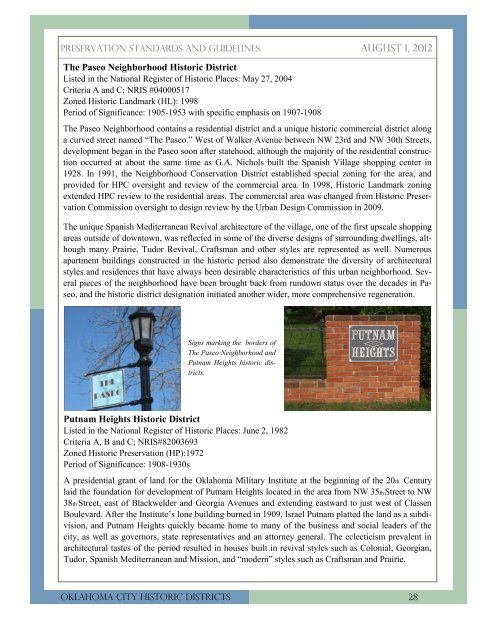Guidelines - City of Oklahoma City
Guidelines - City of Oklahoma City
Guidelines - City of Oklahoma City
Create successful ePaper yourself
Turn your PDF publications into a flip-book with our unique Google optimized e-Paper software.
Preservation Standards AND <strong>Guidelines</strong> August 1, 2012<br />
The Paseo Neighborhood Historic District<br />
Listed in the National Register <strong>of</strong> Historic Places: May 27, 2004<br />
Criteria A and C; NRIS #04000517<br />
Zoned Historic Landmark (HL): 1998<br />
Period <strong>of</strong> Significance: 1905-1953 with specific emphasis on 1907-1908<br />
The Paseo Neighborhood contains a residential district and a unique historic commercial district along<br />
a curved street named ―The Paseo.‖ West <strong>of</strong> Walker Avenue between NW 23rd and NW 30th Streets,<br />
development began in the Paseo soon after statehood, although the majority <strong>of</strong> the residential construction<br />
occurred at about the same time as G.A. Nichols built the Spanish Village shopping center in<br />
1928. In 1991, the Neighborhood Conservation District established special zoning for the area, and<br />
provided for HPC oversight and review <strong>of</strong> the commercial area. In 1998, Historic Landmark zoning<br />
extended HPC review to the residential areas. The commercial area was changed from Historic Preservation<br />
Commission oversight to design review by the Urban Design Commission in 2009.<br />
The unique Spanish Mediterranean Revival architecture <strong>of</strong> the village, one <strong>of</strong> the first upscale shopping<br />
areas outside <strong>of</strong> downtown, was reflected in some <strong>of</strong> the diverse designs <strong>of</strong> surrounding dwellings, although<br />
many Prairie, Tudor Revival, Craftsman and other styles are represented as well. Numerous<br />
apartment buildings constructed in the historic period also demonstrate the diversity <strong>of</strong> architectural<br />
styles and residences that have always been desirable characteristics <strong>of</strong> this urban neighborhood. Several<br />
pieces <strong>of</strong> the neighborhood have been brought back from rundown status over the decades in Paseo,<br />
and the historic district designation initiated another wider, more comprehensive regeneration.<br />
Signs marking the borders <strong>of</strong><br />
The Paseo Neighborhood and<br />
Putnam Heights historic districts.<br />
Putnam Heights Historic District<br />
Listed in the National Register <strong>of</strong> Historic Places: June 2, 1982<br />
Criteria A, B and C; NRIS#82003693<br />
Zoned Historic Preservation (HP):1972<br />
Period <strong>of</strong> Significance: 1908-1930s<br />
A presidential grant <strong>of</strong> land for the <strong>Oklahoma</strong> Military Institute at the beginning <strong>of</strong> the 20th Century<br />
laid the foundation for development <strong>of</strong> Putnam Heights located in the area from NW 35th Street to NW<br />
38th Street, east <strong>of</strong> Blackwelder and Georgia Avenues and extending eastward to just west <strong>of</strong> Classen<br />
Boulevard. After the Institute‘s lone building burned in 1909, Israel Putnam platted the land as a subdivision,<br />
and Putnam Heights quickly became home to many <strong>of</strong> the business and social leaders <strong>of</strong> the<br />
city, as well as governors, state representatives and an attorney general. The eclecticism prevalent in<br />
architectural tastes <strong>of</strong> the period resulted in houses built in revival styles such as Colonial, Georgian,<br />
Tudor, Spanish Mediterranean and Mission, and ―modern‖ styles such as Craftsman and Prairie.<br />
<strong>Oklahoma</strong> <strong>City</strong> Historic Districts 28
















